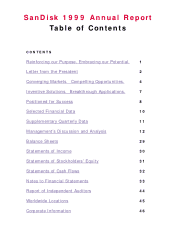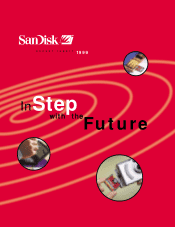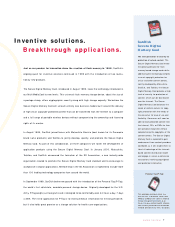SanDisk 1999 Annual Report Download - page 7
Download and view the complete annual report
Please find page 7 of the 1999 SanDisk annual report below. You can navigate through the pages in the report by either clicking on the pages listed below, or by using the keyword search tool below to find specific information within the annual report.
Converging markets.
Compelling opportunities.
SanDisk has focused its research and development efforts on flash memory storage
products since we were founded in 1988. We introduced CompactFlash in 1994, and today
have a team of engineers dedicated to increasing memory capacity, developing advanced features,
and reducing manufacturing costs. During 1999, SanDisk shipped more than three million
CompactFlash memory cards —more than any previous year —and there are currently more than
220 products on the market that use CompactFlash as their primary storage medium. Last year,
sales of CompactFlash accounted for 60 percent of our product revenues.
The rapid emergence of the digital camera market is one of the chief factors driving demand
for CompactFlash. Today there are more than 130 digital cameras available with slots for
CompactFlash. Using CompactFlash as their “digital film”, consumers can capture and store high
resolution photographs, and then transport the images directly to a computer, photo printer, or
other digital device. A whole new generation is discovering the time- and cost-efficiency of
CompactFlash: instead of buying roll after roll of photographic film, they can reuse a single
CompactFlash card over a lifetime.
During 1999, we also began to witness the convergence of the markets for consumer electronics,
wireless communications, and the Internet. The marketplace is being transformed as consumers
opt for smaller, more user-friendly devices that offer mobility, flexibility, and access to a full range
of content. SanDisk’s MultiMediaCard, originally targeted at cellular phone and pager markets, is
finding new applications in emerging markets such as portable digital music players, digital video
cameras, and smart phones.
5
SanDisk’s CompactFlash memory cards
currently range in capacity from 8 to
192MB, and are widely used in digital
cameras, handheld PCs, voice recorders
and any other CompactFlash
compatible device.
SanDisk Type II PC Cards are as con-
venient as floppy disks, but require far
less power and provide considerably
more storage. SanDisk PC Cards are
currently available in capacities ranging
from 8MB to 1.2GB.
The SanDisk MultiMediaCard lets you
carry more music, images, data, and voice
recordings. This small but rugged memory
card is great for Internet music players,
voice recorders, smart phones, and digital
camcorders. It is currently available in
capacities ranging from 8 to 64MB.
SanDisk’s ImageMate external drive is
the fastest, most convenient way to
transfer data between your memory
cards and your computer. The SanDisk
FlashPath is a convenient floppy disk-
shaped adapter that lets you read and
write data to memory cards using your
computer’s floppy disk drive.
SanDisk IDE FlashDrives are solid-state
mass storage systems for use in mobile
computers, communications platforms,
and embedded systems. They maintain
full compatibility with a hard disk drive
but consume less power.
4 Annual Report 1999
CompactFlash Memory Cards
FlashDisk Type II PC Cards
SanDisk MultiMediaCards
ImageMate™Drives and
FlashPath™Adapters
FlashDrives




















